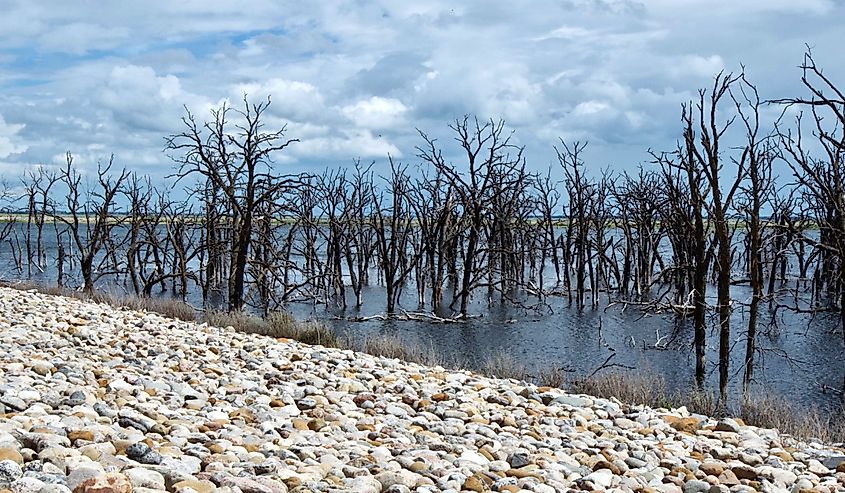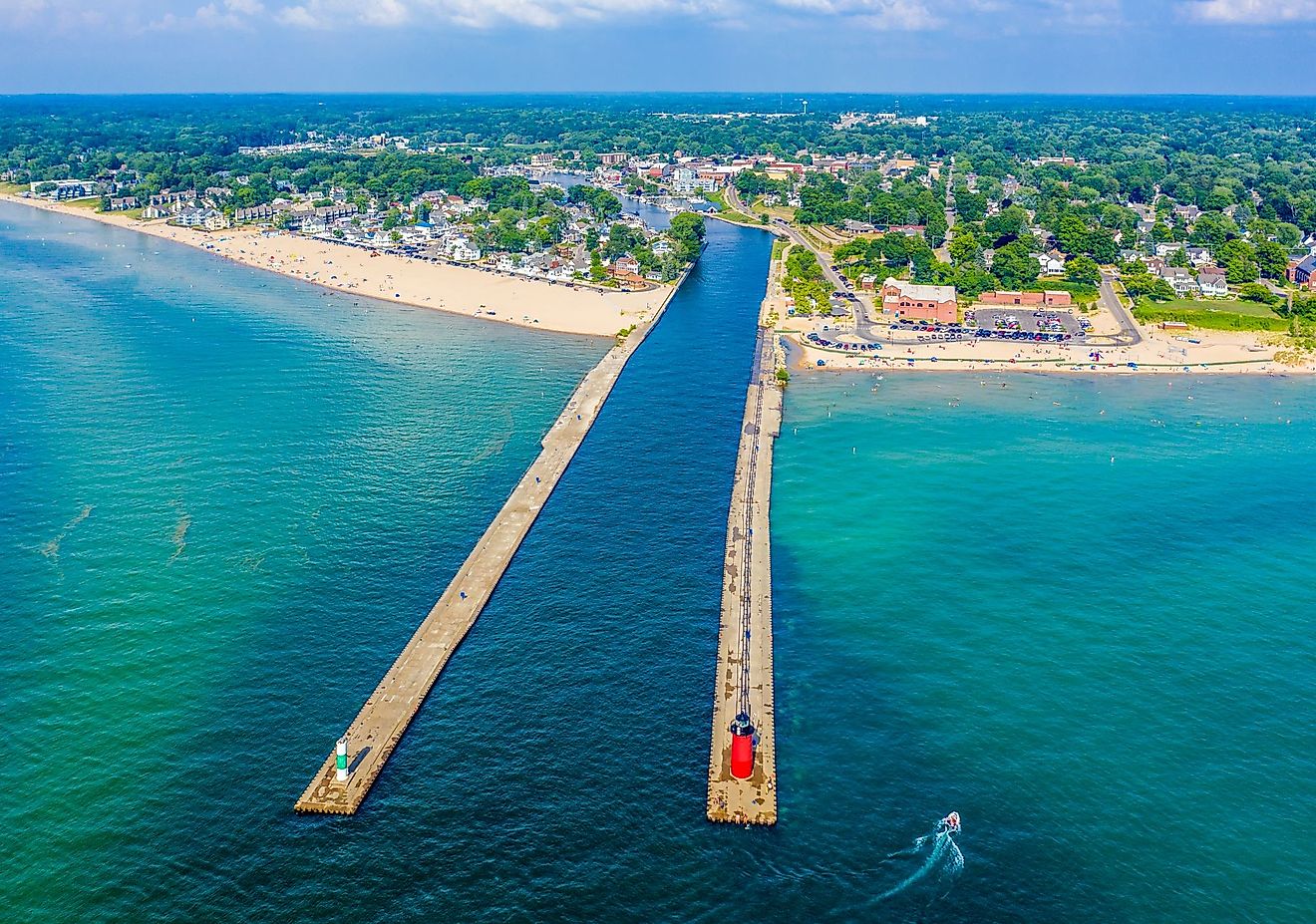
9 Most Beautiful Lakes In North Dakota
North Dakota, known for its picturesque landscapes and diverse ecosystems, is home to a myriad of beautiful lakes. These bodies of water offer not only an array of recreational activities but also serve as important habitats for various flora and fauna. Many of these lakes hold historical significance, providing visitors with a unique opportunity to appreciate both the natural beauty and cultural heritage of the region. On summer days, however, sometimes the best way to appreciate these lakes is from a cozy beachside towel or in the cooling water itself.
Lake Sakakawea

Formed by the Garrison Dam on the Missouri River, Lake Sakakawea boasts a vast expanse of 368,000 acres, making it the third-largest man-made reservoir in the United States. Named in honor of the Shoshone-Hidatsa woman who accompanied Lewis and Clark on their historic expedition, this lake has played a significant role in North Dakota's history. Its extensive shoreline stretches over 1,500 miles, offering countless opportunities for exploration and adventure. Every summer, the lake hosts the annual Sakakawea "Fishing for the Cure" tournament, drawing anglers from near and far to compete and raise money for cancer research.
Devils Lake

Steeped in rich geological history, Devils Lake derives its name from the Native American name "Miniwaukan," meaning "spirit water." This unique body of water is the largest natural lake in North Dakota, covering more than 190,000 acres. The lake's fluctuating water levels, a result of glacial activity thousands of years ago, have fostered the growth of diverse flora and fauna, making it a prime destination for birdwatching and wildlife observation. Devils Lake is also home to the annual Devils Lake Chamber Walleye Classic, a prestigious fishing event that showcases the lake's walleye population.
Lake Metigoshe

Nestled in the picturesque Turtle Mountains, and straddling the Canadian border in northern North Dakota, Lake Metigoshe offers a serene escape into nature. This 1,544-acre lake is a product of glacial activity, with its winding shoreline and numerous bays providing a haven for aquatic life. The surrounding Lake Metigoshe State Park is a testament to the Civilian Conservation Corps' efforts during the 1930s, with many of the park's original structures still standing today. Winter months transform Lake Metigoshe into an idyllic wonderland, as snowmobiling and cross-country skiing become popular activities on the frozen lake and surrounding trails.
Lake Tschida

Created by the construction of Heart Butte Dam on the Heart River, Lake Tschida is a reservoir that spans over 3,400 acres. Its location in the heart of the North Dakota Badlands provides a striking contrast between the rugged landscape and the tranquil waters. One of the unique features of this lake is the presence of several petroglyphs, ancient rock carvings that offer a glimpse into the region's prehistoric past. Lake Tschida is also known for its walleye, northern pike, and smallmouth bass populations, making it a favorite destination for anglers seeking a productive and picturesque fishing spot.
Lake Audubon

Covering 16,000 acres, Lake Audubon is an artificial reservoir created by the Garrison Diversion Unit, a project designed to provide water for irrigation and recreation in North Dakota. The lake's numerous inlets and coves provide a diverse habitat for a wide range of fish species, including northern pike, walleye, and yellow perch. A noteworthy event at Lake Audubon is the annual Audubon Lake (Fargo) Birding Festival, which celebrates the diverse bird species found in the area. The event features guided birdwatching tours and educational workshops. Overall, it is an excellent opportunity for guests and enthusiasts to learn about the ecosystems surrounding the lake.
Long Lake

As a part of the Long Lake National Wildlife Refuge, this 16,000-acre lake is an important sanctuary for migratory birds and other wildlife. The refuge, established in 1932 by President Herbert Hoover, is home to the largest colony of white pelicans in North America, attracting birdwatchers from around the world to observe these bizarre but mystical creatures. Long Lake is also an important habitat for the endangered whooping crane, spotted during migration seasons. The lake's surrounding wetlands and grasslands provide excellent opportunities for wildlife photography.
Lake Ashtabula

Constructed by the Baldhill Dam on the Sheyenne River, Lake Ashtabula spans 5,234 acres and provides an ideal setting for a variety of outdoor activities. Indigenous people who first lived in the area named it Ashtabula, which means "Fish River." Surrounding the lake is the Sheyenne National Grassland, which possesses a proud expanse of prairies, wetlands, and forests. Naturally, the area is therefore steeped in historical significance, with many Native American burial mounds and archaeological sites found nearby. Visitors often check out the lake's recreational opportunities, many of which are water-themed such as canoeing, kayaking, and stand-up paddleboarding. The communities that form around these sports are also extremely vocal about promoting conservation and stewardship of the region's water resources.
Lake Renwick

Situated within Icelandic State Park, the lake is just 5 miles west of Cavalier off Highway 5, making it ideal for a spontaneous family swimming trip. Although many know about it for its striking sapphire waters, Lake Renwick also offers visitors an array of summer recreation opportunities, including swimming, boating, and fishing for species like northern pike. The park also features campgrounds, cabins, boat ramps, trails, picnic shelters, and playgrounds. Lake Renwick was created by the 49-foot-tall Renwick Dam, which impounds the Tongue River for flood control and recreation. In terms of size, for the curious anglers out there, the lake has a surface area of 180 acres and an average depth of 7.2 feet. With its breathtaking surroundings and pristine waters, Lake Renwick is truly a beautiful destination for nature lovers and outdoor enthusiasts alike.
Stump Lake

Stump Lake, in Nelson County, spans 15,742 acres and boasts 72.5 miles of shoreline. This naturally formed, endorheic lake has an average depth of 29.7 feet and reaches a maximum depth of 73.3 feet. The North Dakota Department of Natural Resources stocks the lake with walleye, yellow perch, and northern pike, making it a prime destination for anglers. The lake has experienced significant water level increases in recent years, connecting it to neighboring Devils Lake. Stump Lake Park, dedicated to the lake, offers a variety of recreational activities, including picnic shelters, walking trails, and sports facilities. The park is adjacent to the Nelson County Historical Society's Stump Lake Village, a large pioneer village. Visitors can indulge in the area's natural beauty and history while enjoying excellent fishing opportunities on this unique and thriving body of water.
The beautiful lakes of North Dakota each offer their own unique charm, ranging from serene natural habitats to bustling centers of recreation. Visitors to these lakes are sure to discover stunning landscapes, rich historical connections, and countless opportunities for outdoor adventures. With an abundance of wildlife and a variety of events held throughout the year, North Dakota's lakes serve as a testament to the region's natural beauty and commitment to preserving its valuable ecosystems. Visitors often leave these sacred places with a smile, knowing they made the most of their vacations lakeside.











